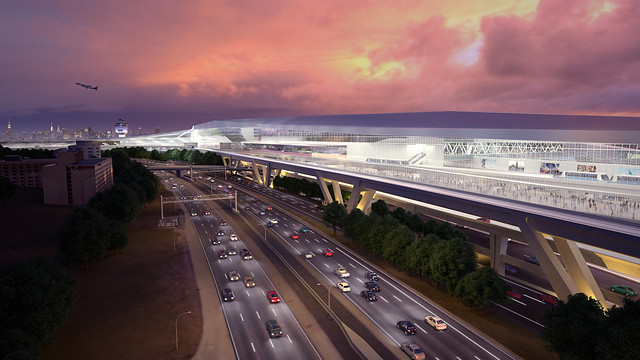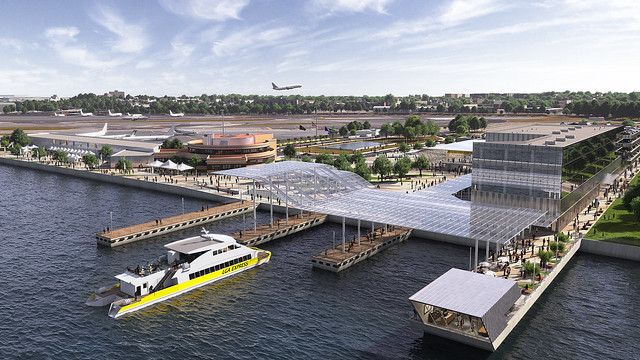
The PATH oculus nears its opening. (Photo via @WTCProgress)
In a few weeks, the Port Authority’s long-awaited, $4 billion subway stop designed by Santiago Calatrava will open for passengers, and when it does, it will open not with a bang but with a deafening whimper. This project, a toxic mix of bureaucratic bumbling, absurd cost overruns, conflicted city and state oversight driven out of control by a lack of interagency cooperation and onerous security concerns, and a starchitect who took advantage of a client unwilling or unable to a say no, doesn’t even have the Port Authority’s enthusiastic support, and the agency essentially said on Monday it won’t even hold a ribbon-cutting ceremony for a building so important that it could wind up on New York State driver’s licenses.
The news of a quiet opening came to us from Dana Rubinstein. As she reported, the Port Authority is too embarrassed by the bad publicity and price tag attached to this project to hold an opening ceremony. There will be no ribbon-cutting, no giant scissors, no self-congratulatory press conference. Instead, New York City will get a $4 opening for a $4 billion colossal.
The Port Authority’s Executive Director Patrick Foye issued a statement to Capital New York in which he explained his concerns with a ceremony. “I’m proud of the work that the Port Authority and hundreds of skilled union workers performed on the Hub,” he said. “Since I arrived here, I have been troubled with the huge cost of the Hub at a time of limited resources for infrastructure so I’m passing on the event.” He later said in no uncertain terms, “The thing is a symbol of excess.”
Meanwhile, as the building gears up for its silent opening, the Port Authority has conducted a few preview tours of the space, and the early word has been decided mixed. Justin Davidson, writing in New York Magazine, found the space visually arresting but also could not look past the price tag. Meanwhile, The Post’s Steve Cuozzo, a frequent critic of the expense of new transit buildings, did not mince words in slamming the building.
The Oculus, which will partially open to the public the first week in March, is as functionally vapid inside as it is outside. It’s a void in search of a purpose other than to connect a bunch of subway and pedestrian corridors and concourses with one another. The ribs rising to a 22-foot-wide skyline frame an impressive ovoid space, for sure. How could a white marble floor 392 feet long, 144 feet wide and a ceiling 160 feet high at its apex not be impressive?
But what will the public find on the vast, 56,448-square-foot floor? Nothing. Not a seat. No newsstands or snack concessions. No central information kiosk like the one that provides a focus to the main hall of Grand Central Terminal, to which Calatrava and the Port Authority presumptuously compare the hub.
Why? An empty floor was Calatrava’s idea. But also, the PA plans to pimp out the Oculus as an event venue, and any installations would get in the way. (How transit riders will make their way around weddings and corporate celebrations remains to be explained.) …The passageways, to open later this year, will let you walk underground all the way from Brookfield Place in Battery Park City to William Street via the MTA’s Fulton Center — although, except in a blizzard, most of us would rather enjoy the sights and sounds of the streets.
At a time when urban design is focused on vibrant street life and local pride, the Calatrava hub is mall above a modestly-used subway station. Its cost is disproportionate to its impact as, on a weekday, the Port Authority counts around 50,000 passengers — on par with the 14th St. subway station that spans the 7th Ave. IRT and 6th Ave. IND and 14th St. BMT platforms. On weekends, the $4 billion subway station sees around just 10,000 riders on Saturday and under 9,000 on Sunday, placing its weekend tally on par with the 6 train’s Parkcester Ave. or 28th St. stations. Imagine if someone proposed spending $2 billion on those stations, let alone $4 billion.
Ultimately, Foye is rightly concerned about the role this building plays in the transit discussion. He has repeatedly called it a “boondoggle” and isn’t afraid to address the fact that the Port Authority isn’t getting much bang for its buck. After all, the $4 billion investment doesn’t include increased service to and from Jersey City, a guarantee that the Port Authority won’t curtail 24-7 PATH service, a connection to Brooklyn, or a one-seat ride to JFK.
We don’t know what future awaits the PATH Hub. As of mid-2013, the Port Authority had hoped to draw retailers willing to spend $550 per square foot to rent out the commercial space, which would make the building yet another mall and one that sits just a block away from the mostly-empty Fulton St. Transit Center, another $1.4 billion expense of questionable return. Yet, will New Yorkers care in 20 or 30 years?
As Nicole Gelinas astutely said to Dana Rubinstein, time has a way of wiping away memories of lost opportunities and too many dollars spent. She said, “It, along with Fulton Center, looks like dead space to me, but we never know how the city will embrace these things until they’re 20 years old. They aren’t really ours; they belong to people who will never know they weren’t there (provided they don’t fall apart).”
New Yorkers of 2035 or 2045 might view the Calatrava hub as something that’s a natural part of the landscape, a mall like the Time Warner Center that no one really wanted but grew to an accepted part of the New York City landscape. But today it reeks of excess and waste that we cannot claw back. That missed opportunity will ring through the decades as well, a sad reminder of opportunities squandered at a time we could least afford to flush transportation dollars down an oculus-ringed drain.







